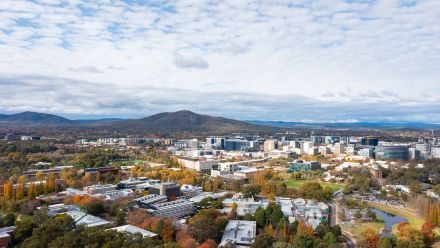Response to Emissions Reduction Assurance Committee
Statement in response to the Emissions Reduction Assurance Committee (ERAC) and Clean Energy Regulator (CER)
This statement can be attributed to Professor Andrew Macintosh and Professor Don Butler from The Australian National University (ANU)
The statement and papers released by the Emissions Reduction Assurance Committee (ERAC), and prepared by the Clean Energy Regulator (CER), are deeply disappointing and raise further concerns about the governance of the Emissions Reduction Fund (ERF).
The ERAC and CER are continuing to deny the serious integrity issues with the Emissions Reduction Fund 's (ERF) two largest methods: human-induced regeneration and landfill gas.
In relation to the human-induced regeneration method, the ERAC and CER have shown a fundamental lack of understanding of the method and the model that is used under the method to estimate sequestration (or tree growth).
The main integrity issue associated with the method is that the CER is allowing projects to be credited for growing trees that were already there when the projects commenced. The position of the ANU research team on this issue is that: (a) by law, the method requires proponents to exclude pre-existing mature trees and shrubs from the areas that are credited; (b) it requires this because the model that is used to estimate sequestration assumes that, at commencement, credited sites only contain juvenile trees and shrubs that will be regenerated through the project (as per the method's full title, 'Human-Induced Regeneration of a Permanent Even-Aged Native Forest'); and (c) relying on the CER's interpretation, proponents have included significant numbers of pre-existing mature trees and shrubs in their credited areas.
The ERAC and CER do not deny that the credited areas contain significant numbers of pre-existing mature trees and shrubs. This directly conflicts with the line taken by the Carbon Market Institute and the main carbon service providers that benefit from the method - their primary defence to date has been to contend that their credited areas do not contain significant numbers of pre-existing mature trees and shrubs.
To defend the status quo, the ERAC and CER argue the method does not require the exclusion of these areas and that the model is calibrated to account for the presence of mature trees and shrubs at commencement.
- Legal interpretation question: If the CER stands by its interpretation of the method, we invite it to join us in seeking declaratory relief on the issue before the Federal Court of Australia. If the CER genuinely believes it is correct, it should not be afraid of allowing the judiciary to adjudicate on the legality of its position. We will even undertake to bear our own costs, reducing the CER's exposure to an adverse cost ruling if it loses.
- Model calibration question: The ERAC's and CER's position on the model and the science that sits behind it is professionally embarrassing and is an indictment on the capacity of both bodies. The model is not calibrated for use in remnant vegetation that contains significant numbers of pre-existing mature trees and shrubs. The ERAC and CER have misinterpreted the model and the science that underpins it. They are defending the inclusion of vast areas of uncleared remnant native vegetation within the credited areas of projects that are supposedly regenerating native forests on previously cleared land. This is a foolish position that will ultimately be proven to be wrong.
On landfill gas, the ERAC and CER have misrepresented the contents of the ANU landfill gas paper and presented a 'strawman' version of the arguments it contains. The ERAC and CER concede the main arguments made in the ANU landfill gas paper: (a) landfills are subject to state/territory regulations that require them to capture and combust a proportion of the gas emitted from the sites; (b) the landfill gas methods seek to capture the impacts of these requirements through the use of a mandated baseline capture rate (i.e. the assumed amount of gas the sites would have captured if they did not receive carbon credits); (c) the default minimum baseline is 30 per cent; (d) there are material non-ERF related financial incentives for landfills to capture and combust gas because they can sell electricity and large-scale generation certificates; (e) the method does not contain any measures to account for the financial incentives landfill gas operators have to capture and combust gas; and (f) 'there are economies of scale in larger plant with multiple generation units because of unit operational cost benefits'.
The main integrity issues associated with the new generation-only landfill gas method centre on the fact that it has allowed most of the largest landfill gas projects to have baselines of 24 per cent (below the default mandatory minimum of 30 per cent), and some to have baselines of zero per cent.
That is, the largest projects, that are generally subject to the most stringent regulatory requirements, and that are most likely to be able to take advantage of material economies of scale in their operations, have the lowest baselines, and some are receiving credits on the basis that, if they did not, they would not capture any gas and would vent it all into the atmosphere, despite the associated public health risks and impacts. This is silly and not worthy of debate. Yet the ERAC endorsed this outcome even though it is required by law to ensure that the method's assumptions are conservative.
The ERAC and CER are clearly afraid of scrutiny on this issue, as evidenced by the fact they have refused to release the April 2021 analysis that the ERAC relied on in reaching its decision to endorse the method. It is also particularly noteworthy that, in its response, the ERAC and CER extensively reference industry data that was provided after the ANU landfill gas paper was published, and personal communications with members of the industry that occurred after the publication of the ANU landfill gas paper.
The decision to make the new generation-only landfill gas method is worth more than $500 million to the landfill gas industry, based on current carbon credit prices. A decision of this magnitude should not be made in the shadows, with no transparency and relying exclusively on selective information provided by the industry that is obtained after integrity issues are raised.
The ERAC and CER continue to defend indefensible positions that undermine confidence in Australia's carbon market and climate action. They do so by relying on data that are inaccessible to outside eyes. We look forward to the independent review of the ERF promised by the new government and hope that it results in much-needed reform of its governance and administration, and improves transparency and integrity in this multibillion dollar industry.
ENDS


